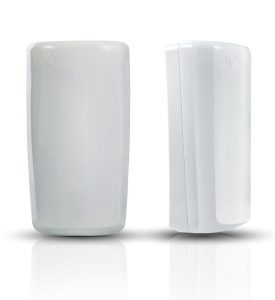We are pleased to present you the 2023 Sustainability Report! With great enthusiasm, we are…

The motion detectors they are mainly used in the security field to detect the movement of any intruder, activating the alarm and communication system, while in the home automation field they can simply be used to detect a presence and, therefore, activate automations or a specific scenario.
Motion sensors: how do they detect presence?
To detect attendance and movement, these sensors can use different technologies. The main ones are two:
- PIR technology (passive infrared) based on a pyroelectric sensor
- dual technology (PIR + Microwave)
The first is based only on the infrared detection of body temperature. The second, which obviously is more expensive, but which is far more reliable against FALSE ALARMS, also associates a microwave that only when both conditions occur (temperature detection close to that of the body + movement detected by the microwave) sends the signal of intrusion to the control panel.
Furthermore, they can be insensitive to pets up to a certain mass (Pet Immune), or be Anti-masking, i.e. able to immediately signal if the lens or mirror they are equipped with is voluntarily covered with a solid and a paint. that prevents it from functioning.
The motion detectors they can be indoor or outdoor, of different range, with different visual coverage and action ranges, to be selected according to their application, location and desired degree of reliability.

Where to install the motion detectors?
Given its nature, the PIR sensor it must always be install away from heat sources and from all those elements that produce temperature variations that could affect the readings, such as radiators, fans or air conditioners. It is also better to avoid objects in its range that produce constant movements, such as pendulum clocks or aquariums.
Sensing normally works best when moving from left to right or vice versa, while it is less responsive when someone is heading directly towards the sensors. Avoid placing them in front of mirrors or windows, as in this case the infrared bounces back and forth, causing false alarms to be detected.
Ksenia Security ‘unum’ PIR motion detector
It should be noted right away that unum by Ksenia Security it’s a professional and certified detector. It is not analog, but completely digital (based on a HighBar ASIC processor), has a range of 12 meters and a field of view around 90 °. It is the fruit of an extremely sought after project which, instead of using a protruded lens, has a single large high-density polyethylene (HDPE) lens that also acts as a front, ensuring a superior optics and a sober and minimalist style. Thanks to their aesthetic design, the unum detectors they integrate without being noticed in any interior architecture.
The motion detectors unum series are therefore the only ones on the market in ELT technology (Embedded Lens Technology). The signaling LEDs enclosed within them allow a soft and unobtrusive light signal. They are called unum also because they have a unique profile and shape for all the technologies described (even from the outside they are identical both in the wired and wireless version), thus acting as a further deterrent to the attacker who, being absolutely unable to know the technology contained therein, will not know how to avoid detection.





